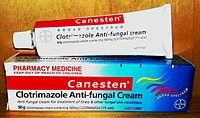
Photo from wikipedia
Fungal infections, named mycosis, can cause severe invasive and systemic diseases that can even lead to death. In recent years, epidemiological data have recorded an increase in cases of severe… Click to show full abstract
Fungal infections, named mycosis, can cause severe invasive and systemic diseases that can even lead to death. In recent years, epidemiological data have recorded an increase in cases of severe fungal infections, caused mainly by a growing number of immunocompromised patients and the emergence of fungal pathogenic forms that are increasingly resistant to antimycotic drug treatments. Consequently, an increase in the incidence of mortality due to fungal infections has also been observed. Among the most drug-resistant fungal forms are those belonging to the Candida and Aspergillus spp. Some pathogens are widespread globally, while others are endemic in some areas only. In addition, some others may represent a health threat for some specific subpopulations and not for the general public. In contrast to the extensive therapeutic armamentarium available for the antimicrobial chemotherapeutic treatment of bacteria, for fungal infections there are only a few classes of antimycotic drugs on the market, such as polyenes, azoles, echinocandins, and a few molecules are under trial. In this review, we focused on the systemic mycosis, highlighted the antifungal drug compounds available in the pipeline, and analyzed the main molecular mechanisms for the development of antifungal resistance to give a comprehensive overview and increase awareness on this growing health threat.
Journal Title: Biomedicines
Year Published: 2023
Link to full text (if available)
Share on Social Media: Sign Up to like & get
recommendations!